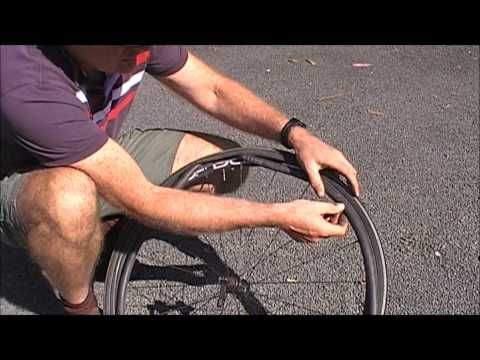By Jimmy Lewis
Changing tires is hard enough for most riders in perfect conditions, but what do you do if forced to do it out on the trail? We’ll give you some insight based on years of experience learning the rights and wrongs of the process.
Have the right tools. How do you make sure? Use them in a garage tire change to verify it. The basics are; wrenches/sockets to remove the axel, wrench/socket for the rim lock, something to keep dirt out of the bearings, valve core remover, compact tire irons and a compact tire pump. An extra valve core and a valve stem nut can come in handy too.
How do you hold up the bike? What do you use for a stand? Or do you even need one? Logs are great, rocks can work and we’ve even laid a bike over on the side or dropped/ hung the bike on a ledge to allow easier wheel removal. The answer is to use what is available. Often a little hunting for a proper nature-made stand can really save time and effort.
And remember the “balance” of the bike will drastically change when the wheel comes off, so expect that.
A great place to store the axle is in the muffler. Also, keep the loose parts away from the working area because we all know how hard it is to find parts that have been kicked or buried in the dirt or even worse sand.
The techniques for the actual tire change do not change on the trail. So if you do not have these techniques, they will not manifest in this time of need. So yes, practicing this in the garage is a good idea. If your tire requires breaking the bead off the rim, having specialty tire irons can go a long way. Or you can ride the flat tire till it breaks off the bead or becomes hot and easier to remove, yes we have done this in a pinch. If equipped, loosen the rim lock(s) first.
You can use a shop rag to keep dirt out of the wheel bearings, but there are some tough and compact changing mats that give you a much-improved workspace.
Since you should have knee protection on, put those knees to good use in keeping the tire down into the dish of the rim as you work.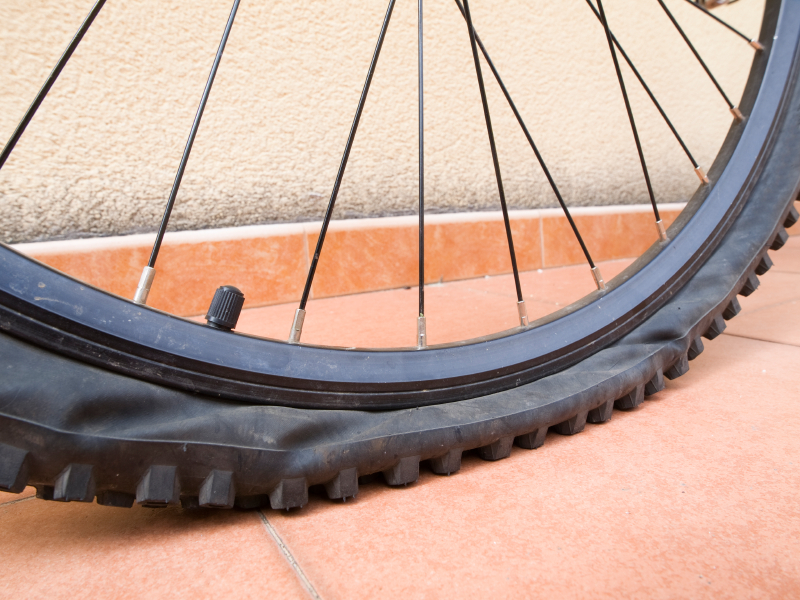 Do you take the tire off the rim or just replace the tube, out and in? It depends on the type of flat and if you need to be sure that whatever caused the original flat will not cause another one. If there is any doubt, take the tire off the rim to inspect and clean it out.
Do you take the tire off the rim or just replace the tube, out and in? It depends on the type of flat and if you need to be sure that whatever caused the original flat will not cause another one. If there is any doubt, take the tire off the rim to inspect and clean it out.
What do you put back in the tire? A new tube would be ideal, but out on the trail, the truthful answer is, whatever you have available. In order of preference, here is a list: new tube of the correct size, new tube of incorrect size (i.e. 21” front tube stuffed in the rear tire, that is why most riders carry only a spare front tube), or patch the flat tube. But wait, there’s more! If desperate, you can rely on the last resort/Hail Mary methods. We’ve pulled the part of the tube with the pinch in it, secured wire around the tube beneath the hole, and isolated the leak by twisting the wire tightly (it worked.) You can use heavy zip ties to secure a flat tire to the rim if no other solution is found. And we have even stuffed leaves and pine needles into a flat tire as sort of an “organic mousse.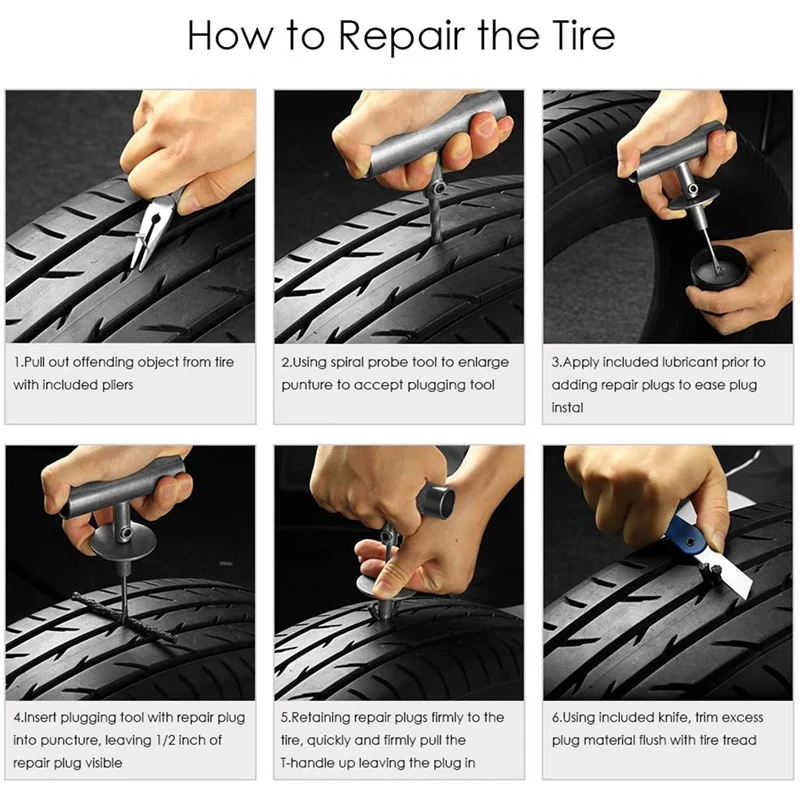 ” When you’re screwed…Remember you could have been better prepared.
” When you’re screwed…Remember you could have been better prepared.
Edit
Edit
The wheel is now off. Now you should take the valve core out of the tire with a valve core tool, and release all the air. Use a size 12mm wrench and take the nuts off the valve stem, and the bead lock. Which is the other thing in the rim with a nut on it besides the valve stem.
Edit
Edit
Edit
Once the tire is back on the rim add more air this should push the bead lock out. Now you can put the nut back on the bead lock as well.(do not tighten yet.) make sure the tire is at the correct pressure and everything looks good, now you can tighten down the bead lock, and the valve stem. After the valve stem is tight put the second nut on.
Edit
Remember when I told you to mark where your tightening blocks where? This is where that comes into play. Align the blocks to their original spot, then tighten the nut on the axle. Now you are done, and your bike is ready to ride.
Edit
with 5 other contributors
Badges: 5
+2 more badges
Everyone loves to ride a bike.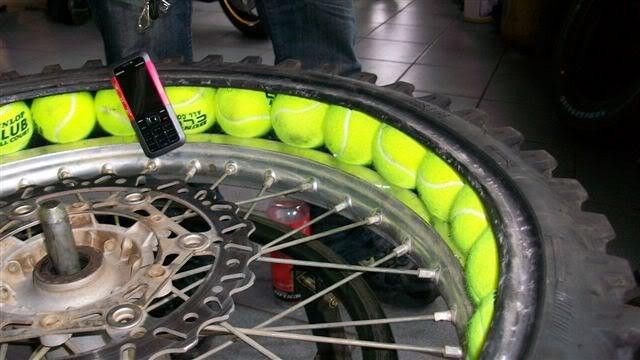 Well, almost everything. And the head of the metropolitan traffic police, Dmitry Korzyuk, rides it, and the founder of the Internet portal TUT.BY, Yuri Zisser. But will cyclists be able to fix a two-wheeled vehicle if a wheel suddenly breaks on the road? Blogger Alexander Deshchenko decided to fill this gap.
Well, almost everything. And the head of the metropolitan traffic police, Dmitry Korzyuk, rides it, and the founder of the Internet portal TUT.BY, Yuri Zisser. But will cyclists be able to fix a two-wheeled vehicle if a wheel suddenly breaks on the road? Blogger Alexander Deshchenko decided to fill this gap.
A bicycle is a rather complicated technique. And any technique tends to fail over time. I will try to enlighten those interested in common breakdowns, as well as throw in some repair ideas.
There are plenty of parts on the bike. Of course, it does not reach the tractor, but still it will take a couple of days for someone who decides to take care of studying the names and purposes of at least most of them. Therefore, we will not deal with this, we will limit ourselves to the minimum that is necessary for successful and safe movement.
If your bike rides, the pedals turn without extraneous sounds, and the gears (if equipped) change easily and naturally, you can be envied. Seriously - as with people, there are no completely serviceable bicycles, there are underexamined ones.
Seriously - as with people, there are no completely serviceable bicycles, there are underexamined ones.
The most common "disease" among new bikers is flat tires. Rubber is not completely sealed, and over time, tire pressure decreases. In addition, the cleanest city in the world does not let you relax, from time to time providing an excuse to practice bicycle repair.
If such a misfortune has overtaken you, do not panic - of all bicycle diseases, blown-out wheels are the easiest to "treat". If at home you found a flat tire during the second whole, try pumping up, maybe you just didn’t pump up the previous time.
By the way, pumps are cheap, portable and good, you can choose any two characteristics. Personally, I always have an inexpensive portable (more precisely, portable, because it hangs on a frame) pump at hand, and at home there is a good stationary one. In principle, pumping wheels is also better in the mind. At the end of any, even the cheapest and Chinese tires, the working pressures for which this tire is designed are indicated. If you don’t pump enough, you run the risk of breaking through on any bend in the terrain. If you pump it over - you can simply burst, like Piglet's balloon in the famous cartoon. Although, of course, there is a pattern "pumped up less - it's softer to ride, pumped up more - it rolls better."
If you don’t pump enough, you run the risk of breaking through on any bend in the terrain. If you pump it over - you can simply burst, like Piglet's balloon in the famous cartoon. Although, of course, there is a pattern "pumped up less - it's softer to ride, pumped up more - it rolls better."
But back to the flat tire. If you pumped it up, and it went down again, then it’s bad business with him, not with you. But here, too, you should not be especially upset. It is quite possible that when the wheel is inflated with the naked ear, a whistle of air is heard, or even some foreign object sticks out, indicating the place of the puncture.
If the rupture is visible, you can pull out a piece of the chamber with a hole, glue it, put it back and do not even remove the wheel from the fork. In bike shops you can find a wonderful mobile kit for patching wheels, a small box is sold for little money, the lid of which is two plastic spatulas for disassembling the tire, and inside there is a number of patches, a tube of glue and a piece of sandpaper.
If you have an interest in cycling, I highly recommend it, the thing is simply irreplaceable. Of course, the set is more likely to be marching and will not help in difficult situations, however, most of the common punctures heal.
By the way, the patches from the kit are quite large in size, they can be additionally cut into several smaller ones. It is very simple to seal the hole found on the camera - you clean the surface around it a little, smear it with glue and press the patch tightly. Usually they are made of "raw" rubber, so the main thing is to fix it correctly on the camera, carefully fill it back into the wheel and pump it up, and then under pressure it will flatten to almost zero thickness and implant like a native. And finally, you can inspect the tire itself for cuts.
Based on materials from the Avto.tut.by portal
It's time to turn on spring and update your technical wardrobe.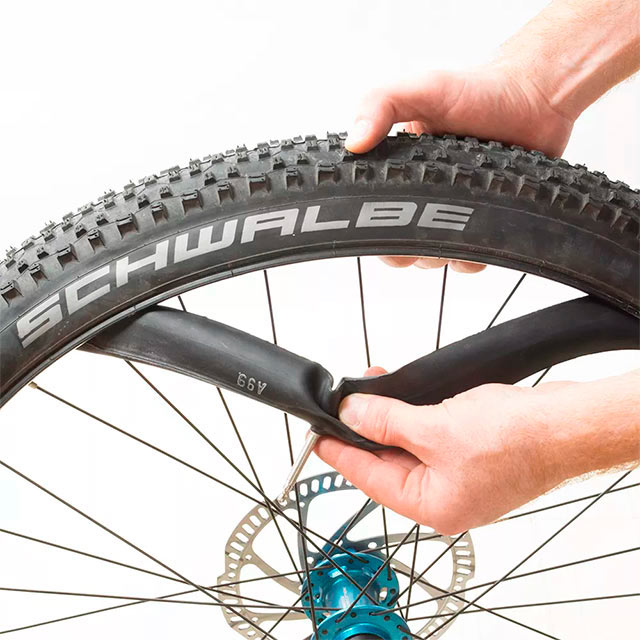 Surely your young lady has been dreaming of a beautiful bike for a long time or has already grown out of the previous one. It's time to make a choice and have time to buy a 24-inch bike with a favorable discount. Female teen models, of course, not much ...
Surely your young lady has been dreaming of a beautiful bike for a long time or has already grown out of the previous one. It's time to make a choice and have time to buy a 24-inch bike with a favorable discount. Female teen models, of course, not much ...
We are often asked - "...what is a butyl inner tube for a wheel?". Let's read this short article together to get the answer to this question. Let's start with the definition of what is butyl? Butyl is a highly elastic and airtight synthetic rubber, to which…
Artem Gorev, a cycling specialist, dispels all myths. Most people who want to buy a bike are not particularly knowledgeable about the subject and have a natural desire to consult with someone before buying, and they: - turn to their friends for help, ...
Bicycle specialist Artem Gorev advises: Every time I sell a bike to a person who is at the very foot of the cycling Olympus, I give a short briefing, i. e. I list the most important, in my opinion, points that a novice cyclist should remember in ...
e. I list the most important, in my opinion, points that a novice cyclist should remember in ...
Valuable advice is given by bicycle safety specialist Artem Gorev. Oddly enough, but with age you begin to appreciate life more (at least, I noticed such a feature in myself), it would be nice to think about the reasons for this paradox, but I will restrain myself, the purpose of this article is somewhat different.…
Artem Gorev, expert on safe cycling, tells. You bought a bike and hit the road for the first time. Of course, you are aware that this is not a safe business, but excellent knowledge (and observance) of the rules of the road relaxes you, an ugly inner voice whispers ...
Bicycle specialist Artem Gorev conducts research and gives advice. The other day I read an interesting article written by American professional rider Neil Bezdek called Finding the Right Cycling Coach. In addition to advice on choosing a coach, ...
In addition to advice on choosing a coach, ...
The seasonal problem of all outdoor enthusiasts is what to do with the bike in winter. If you are not an extreme, ready to ride in snowdrifts, then for five months you need to attach an iron horse somewhere. In fact, the bicycle turns out to be a very fragile creature, and even if it withstands wintering ...
A city bike needs a professional service once a year, while a cross-country bike requires more frequent workshop visits. According to Kert Olle, head of technical products at Rattamaailm, home care of a bicycle starts right from the very…
Tires have a huge impact on the performance of a bike. We will reveal all the secrets... Camera: To be or not to be? Conventional tires use an inner tube filled with air, but how do tubeless tires work? In most…
Jump to page:
Content
Problems that are constantly accompanied by collars, constantly accompany the coats, constantly accompanied outdoor enthusiasts and athletes.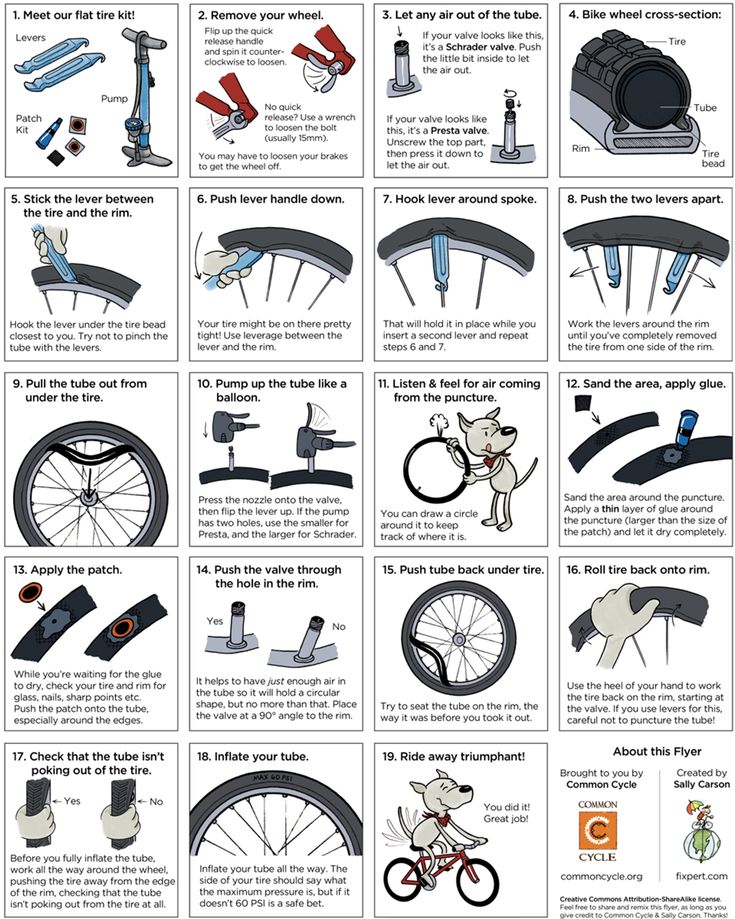 If professionals have a whole staff of employees involved in servicing bikes, then amateurs have to decide on their own the question of why they flatten a wheel on a bicycle.
If professionals have a whole staff of employees involved in servicing bikes, then amateurs have to decide on their own the question of why they flatten a wheel on a bicycle.
An annoying nuisance that seems impossible to avoid. But this is only at first glance. Often we ourselves are to blame for the flat tire of the bike. What is it about? Read on.
There are at least five reasons that can spoil your mood before a bike ride or during a bike ride:
Let's look at each problem separately and find out what's wrong.
The most common tire on a bicycle is a flat tire that has outlived its useful life. The surface of the tire becomes more viscous, collecting various debris, small glasses, and so on. All the little things gradually penetrate inside, up to the camera. As a result, another puncture.
All the little things gradually penetrate inside, up to the camera. As a result, another puncture.
In addition, holes are formed on the used rubber, through which the bicycle tube is visible when inflated. It can simply come into contact with the road when driving. This will inevitably lead to another unpleasant situation.
They sealed the tube after a puncture using a flipper tape, but the working element still constantly lowers. Perhaps there was a piece of glass in the tire. It is difficult to detect and constantly creates problems for the cyclist.
Note!
Before beading, carefully check the wheel for small stones, glass and other foreign debris.
Beading and disassembling the wheel, you need to use a special tool - beading blade. Avoid screwdrivers, wrenches, and so on.
In this case, there is not enough shock absorption. You can get a puncture by running into, for example, a pointed pit.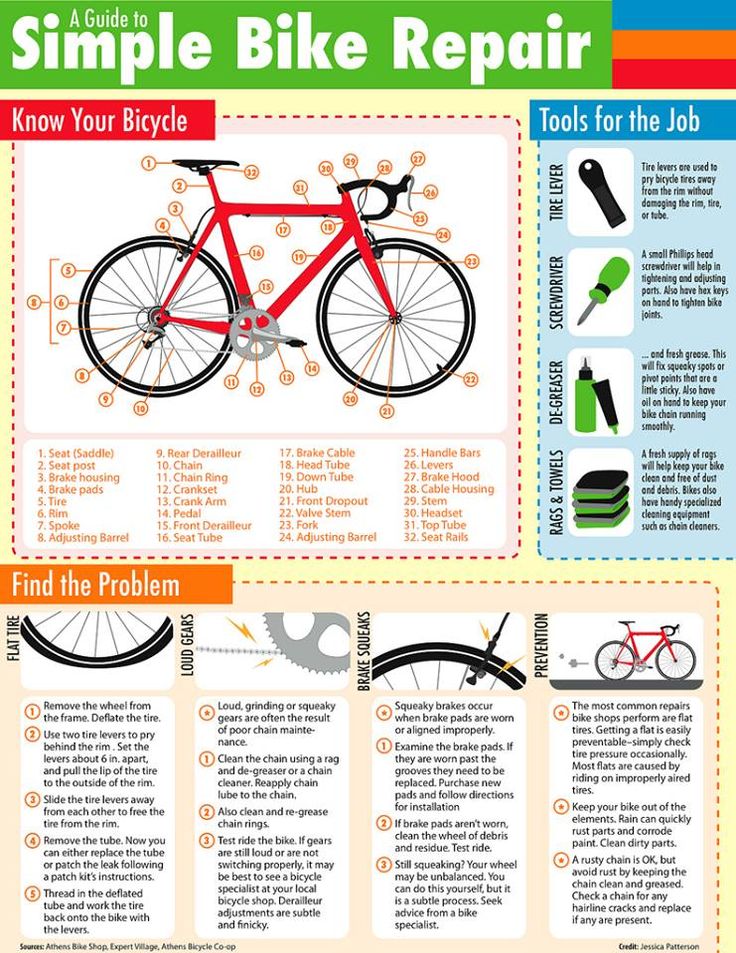
Another reason why a flat tire on a bicycle. On the inside, the rim is glued with a flipper tape. It is she who guards the camera. An overfilled element may tear the flipper or burst.
It's true that protective tape can be a problem. It is tough with sharp edges. If installed incorrectly, the chamber can be cut.
Please note! Continuous use of the anti-puncture chamber reduces the wear resistance of the tire.
A bicycle first aid kit or repair kit is available from retailers and specialist shops. "Technical treatment" after finding a puncture does not take more than 5 minutes.
Camera needs to be removed. Pump it up and grease it with glue. Then apply on the patch. Wait for the glue to set, and after 5 minutes the camera can be mounted.
To prevent a flat tire, it is important to follow the manufacturer's recommendations.